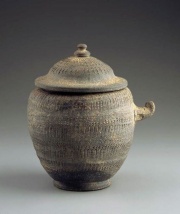Alkaline glaze
Description
A Ceramic glaze that has an alkaline flux, such as Borax, Potash, or Soda ash (Mayer 1969). Alkaline glazes can produce brilliant colors, such as Egyptian blue, using low temperature firing. However, the alkali materials are often hygroscopic resulting in lumpy, poorly dispersed suspensions. In addition, if the composition contains too much alkali, the glaze maybe susceptible to crazing. A typical composition for an alkaline glaze is: Alumina (10-15%), Silica (30-70%), potash (up to 15%), Lime (up to 15%) with variable small quantities of iron oxide, Magnesia, and phosphates (Hodges, 1988).
Synonyms and Related Terms
soda-lime glaze; glaçure alcaline (Fr.); alkalisch glazuur (Ned.); vidrado alcalino (Port.); soda lime glaze; potash-lime glaze, ash glaze; kiln ash glaze; salt glaze
Resources and Citations
- Ralph Mayer, A Dictionary of Art Terms and Techniques, Harper and Row Publishers, New York, 1969 (also 1945 printing)
- Henry Hodges, Artifacts: An Introduction to Early Materials and Technology, Ronald P. Frye, Kingston, Canada, 1988
- Robert Fournier, Illustrated Dictionary of Practical Pottery, Chilton Book Company, Radnor, PA, 1992
- Art and Architecture Thesaurus Online, http://www.getty.edu/research/tools/vocabulary/aat/, J. Paul Getty Trust, Los Angeles, 2000

